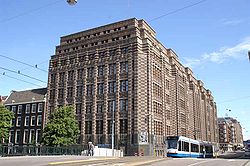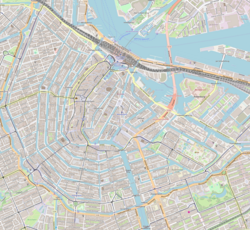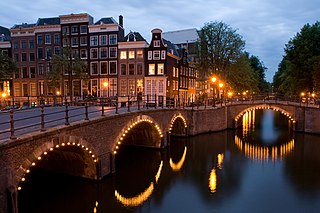
Amsterdam is the capital and most populous city of the Netherlands, with The Hague being the seat of government. It has a population of 921,402 within the city proper, 1,457,018 in the urban area and 2,480,394 in the metropolitan area. Located in the Dutch province of North Holland, Amsterdam is colloquially referred to as the "Venice of the North", for its large number of canals, now designated a UNESCO World Heritage Site.

Saskia van Uylenburgh was the wife of painter Rembrandt van Rijn. In the course of her life, she was his model for some of his paintings, drawings and etchings. She was the daughter of Rombertus Uylenburg, the mayor as well as the justice of the Court of Friesland.

The Amstel is a river in the province of North Holland in the Netherlands. It flows from the Aarkanaal and Drecht in Nieuwveen northwards, passing Uithoorn, Amstelveen, and Ouderkerk aan de Amstel, to the IJ in Amsterdam. Annually, the river is the location of the Liberation Day concert, Head of the River Amstel rowing match, and the Amsterdam Gay Pride boat parade.

The Oude Kerk is Amsterdam’s oldest building and youngest art institutes. The building was founded circa 1213 and consecrated in 1306 by the bishop of Utrecht with Saint Nicolas as its patron saint. After the Reformation in 1578, it became a Calvinist church, which it remains today. It stands in De Wallen, now Amsterdam's main red-light district. The square surrounding the church is the Oudekerksplein.
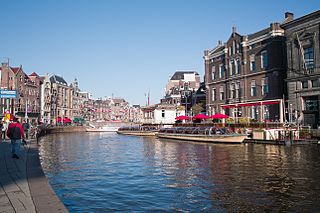
The Rokin is a canal and major street in the centre of Amsterdam. The street runs from Muntplein square to Dam square. The Rokin canal used to run from Muntplein square to Dam Square, but in 1936, the part between Spui square and Dam Square was filled in. Canal boats are now moored on the remaining part of the water, from the Amstel to Grimburgwal.

Frans Banninck Cocq, lord of Purmerland and Ilpendam (1605–1655) was a burgemeester (mayor), knight and military person of Amsterdam in the mid-17th century. He belonged to the wealthy and powerful Dutch patriciate of the Dutch Golden Age. Banninck Cocq is best known as the central figure in Rembrandt's masterpiece The Night Watch.

The Singel is one of the canals of Amsterdam. The Singel encircled Amsterdam in the Middle Ages, serving as a moat around the city until 1585, when Amsterdam expanded beyond the Singel. The canal runs from the IJ bay, near the Central Station, to the Muntplein square, where it meets the Amstel river. It is now the inner-most canal in Amsterdam's semicircular ring of canals.

Amsterdam, capital of the Netherlands, has more than 100 kilometers (62 mi) of grachten (canals), about 90 islands and 1,500 bridges. The three main canals, dug in the 17th century during the Dutch Golden Age, form concentric belts around the city, known as the Grachtengordel. Alongside the main canals are 1550 monumental buildings. The 17th-century canal ring area, including the Prinsengracht, Keizersgracht, Herengracht and Jordaan, were listed as UNESCO World Heritage Site in 2010, contributing to Amsterdam's fame as the "Venice of the North".

The Alteratie is the name given to the change of power in Amsterdam on May 26, 1578, when the Catholic city government was deposed in favor of a Protestant one. The coup should be seen in the context of the greater Dutch Revolt that was breaking out in this time. Trade interests played an important role, because Amsterdam was becoming isolated as surrounding cities and towns joined the revolt, and other cities were threatening to take over its trade. No one was injured or killed during the coup. On May 29, a new city council was formed, consisting of 30 Calvinists and 10 Catholics. Already after a few months, plans were presented to expand the city and the harbor on the eastern side (Lastage), and to construct new defensive fortifications.

Jacob Dircksz de Graeff, free lord of Zuid-Polsbroek was an illustrious member of the patrician De Graeff family. He was a powerful politician of the States Faction, regent and mayor of Amsterdam after the political collapse of Reynier Pauw in 1627.

Leendert Viervant de Jonge, was a Dutch architect and cabinet builder.

The Nieuwe Waalse Kerk is a late 19th-century church building on the Keizersgracht canal in Amsterdam. The building, a rare example of Romanesque Revival architecture in Amsterdam, has rijksmonument status.
The following is a timeline of the history of the municipality of Amsterdam, Netherlands.

The Walloon Church is a Protestant church building in Amsterdam, along the southern stretch of the Oudezijds Achterburgwal canal. The building dates to the late 15th century and has been in use as a Walloon church since 1586. The church was also known as the Franse Kerk, Walenkerk, Oude Walenkerk, or Oude Waalse Kerk.
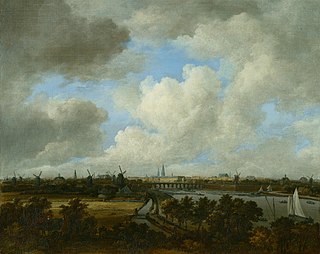
View on the Amstel from Amsteldijk is an oil on canvas painting by the Dutch landscape painter Jacob van Ruisdael. It is an example of Dutch Golden Age painting and is now in the collection of the Amsterdam Museum.

The Oudezijds Voorburgwal, often abbreviated to OZ Voorburgwal, is a street and canal in De Wallen in the center of Amsterdam. The OZ Voorburgwal runs from the Grimburgwal in the south to the Zeedijk in the north, where it changes into the Oudezijds Kolk, which drains into the IJ.

The Oudeschans, or Oude Schans, originally the Nieuwe Gracht, is a wide canal in the eastern part of the inner city of Amsterdam.

The Spuistraat in downtown Amsterdam connects the Hekelveld to the Spui. It runs roughly north to south, parallel to the Singel and the Nieuwezijds Voorburgwal. At the Royal Palace of Amsterdam, the Spuistraat crosses the Raadhuisstraat and Paleisstraat. Originally the Spuistraat was a canal, the Nieuwezijds Achterburgwal. The canal was filled in in 1867, and the street renamed then.

Pieter Dircksz Graeff was a descendant of the Dutch regent family De Graeff. The Lord of Engelenburg was born as the third son of Dirk Jansz Graeff and Agniet Pietersdr van Neck.
